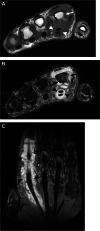MRI nomenclature for musculoskeletal infection
- PMID: 34145466
- PMCID: PMC8789645
- DOI: 10.1007/s00256-021-03807-7
MRI nomenclature for musculoskeletal infection
Erratum in
-
Correction to: MRI nomenclature for musculoskeletal infection.Skeletal Radiol. 2022 May;51(5):1103-1104. doi: 10.1007/s00256-022-03999-6. Skeletal Radiol. 2022. PMID: 35083546 Free PMC article. No abstract available.
Abstract
The Society of Skeletal Radiology (SSR) Practice Guidelines and Technical Standards Committee identified musculoskeletal infection as a White Paper topic, and selected a Committee, tasked with developing a consensus on nomenclature for MRI of musculoskeletal infection outside the spine. The objective of the White Paper was to critically assess the literature and propose standardized terminology for imaging findings of infection on MRI, in order to improve both communication with clinical colleagues and patient care.A definition was proposed for each term; debate followed, and the committee reached consensus. Potential controversies were raised, with formulated recommendations. The committee arrived at consensus definitions for cellulitis, soft tissue abscess, and necrotizing infection, while discouraging the nonspecific term phlegmon. For bone infection, the term osteitis is not useful; the panel recommends using terms that describe the likelihood of osteomyelitis in cases where definitive signal changes are lacking. The work was presented virtually to SSR members, who had the opportunity for review and modification prior to submission for publication.
Keywords: Abscess; MRI; Musculoskeletal infection; Osteomyelitis.
© 2021. ISS.
Conflict of interest statement
The authors declare no conflict of interest.
Figures



















Similar articles
-
SSR white paper: guidelines for utilization and performance of direct MR arthrography.Skeletal Radiol. 2024 Feb;53(2):209-244. doi: 10.1007/s00256-023-04420-6. Epub 2023 Aug 11. Skeletal Radiol. 2024. PMID: 37566148 Free PMC article. Review.
-
CT and MRI evaluation of musculoskeletal infection.Crit Rev Diagn Imaging. 1997 Dec;38(6):535-68. Crit Rev Diagn Imaging. 1997. PMID: 9442978 Review.
-
Imaging of Musculoskeletal Infection.Rheum Dis Clin North Am. 2016 Nov;42(4):769-784. doi: 10.1016/j.rdc.2016.07.010. Epub 2016 Sep 7. Rheum Dis Clin North Am. 2016. PMID: 27742026 Review.
-
ACR Appropriateness Criteria® Suspected Osteomyelitis, Septic Arthritis, or Soft Tissue Infection (Excluding Spine and Diabetic Foot).J Am Coll Radiol. 2017 May;14(5S):S326-S337. doi: 10.1016/j.jacr.2017.02.008. J Am Coll Radiol. 2017. PMID: 28473089 Review.
-
Musculoskeletal infection: findings on magnetic resonance imaging.Can Assoc Radiol J. 1994 Oct;45(5):355-62. Can Assoc Radiol J. 1994. PMID: 7922715 Review.
Cited by
-
Imaging of Musculoskeletal Soft-Tissue Infections in Clinical Practice: A Comprehensive Updated Review.Microorganisms. 2022 Nov 25;10(12):2329. doi: 10.3390/microorganisms10122329. Microorganisms. 2022. PMID: 36557582 Free PMC article. Review.
-
Radiological Assessment of Charcot Neuro-Osteoarthropathy in Diabetic Foot: A Narrative Review.Diagnostics (Basel). 2025 Mar 19;15(6):767. doi: 10.3390/diagnostics15060767. Diagnostics (Basel). 2025. PMID: 40150109 Free PMC article. Review.
-
Spectrum of imaging findings in soft-tissue necrosis.Emerg Radiol. 2023 Apr;30(2):217-223. doi: 10.1007/s10140-023-02113-0. Epub 2023 Jan 10. Emerg Radiol. 2023. PMID: 36626029
-
Osteomyelitis of the Lower Limb: Diagnostic Accuracy of Dual-Energy CT versus MRI.Diagnostics (Basel). 2023 Feb 13;13(4):703. doi: 10.3390/diagnostics13040703. Diagnostics (Basel). 2023. PMID: 36832191 Free PMC article.
-
MRI-guided sacroiliac joint injections in children and adults: current practice and future developments.Skeletal Radiol. 2023 May;52(5):951-965. doi: 10.1007/s00256-022-04161-y. Epub 2022 Aug 25. Skeletal Radiol. 2023. PMID: 36006462 Review.
References
-
- Duryea D, Bernard S, Flemming D, Walker E, French C. Outcomes in diabetic foot ulcer patients with isolated T2 marrow signal abnormality in the underlying bone: should the diagnosis of "osteitis" be changed to "early osteomyelitis"? Skeletal Radiol. 2017;46(10):1327–1333. - PubMed
-
- Hoang D, Fisher S, Oz OK, La Fontaine J, Chhabra A. Percutaneous CT guided bone biopsy for suspected osteomyelitis: diagnostic yield and impact on patient's treatment change and recovery. Eur J Radiol. 2019;114:85–91. - PubMed
-
- Lipsky BA, Berendt AR, Cornia PB, Pile JC, Peters EJ, Armstrong DG, et al. 2012 Infectious Diseases Society of America clinical practice guideline for the diagnosis and treatment of diabetic foot infections. Clin Infect Dis. 2012;54(12):e132–173. - PubMed
-
- American College of Radiology, ACR Manual on Contrast Media. 2021.
Publication types
MeSH terms
Grants and funding
LinkOut - more resources
Full Text Sources
Medical

